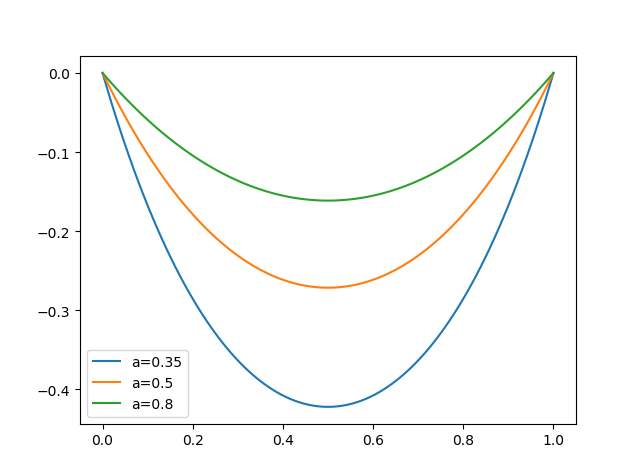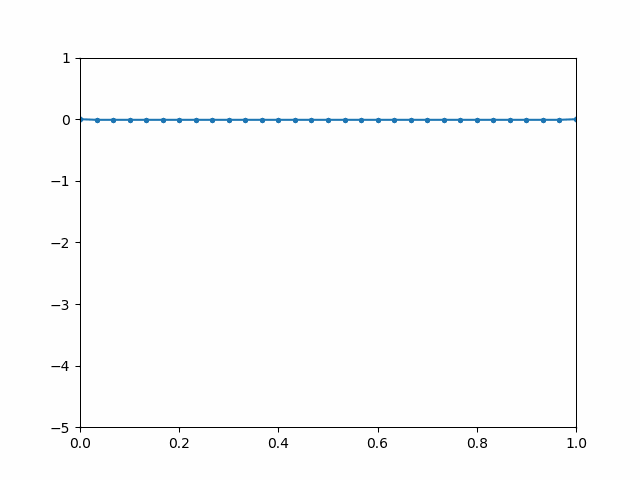
6

【趣味小题】悬链线的力学模拟
source link: https://www.guofei.site/2020/01/25/catenary.html
Go to the source link to view the article. You can view the picture content, updated content and better typesetting reading experience. If the link is broken, please click the button below to view the snapshot at that time.

【趣味小题】悬链线的力学模拟
2020年01月25日Author: Guofei
文章归类: 趣文,文章编号:
版权声明:本文作者是郭飞。转载随意,但需要标明原文链接,并通知本人
原文链接:https://www.guofei.site/2020/01/25/catenary.html
悬链线
y=acoshxay=acoshxa
1. 画图
import numpy as np
import matplotlib.pyplot as plt
def catenary(x, a):
return a * np.cosh((x - 0.5) / a) - a * np.cosh((-0.5) / a)
x = np.linspace(0, 1, 100)
for a in [0.35, 0.5, 0.8]:
plt.plot(x, catenary(x, a), label='a={:g}'.format(a))
plt.legend()
plt.show()

2. 计算长度
曲线长度可以这么计算:
s=∫1+(dydx)2−−−−−−−−√dxs=∫1+(dydx)2dx
先用粗略的方法估计:
y=catenary(x,0.35)
(((np.diff(y))**2+np.diff(x)**2)**0.5).sum()1.3765522648842718
3. 力学模拟法
# 悬链线的力学模拟
import numpy as np
class Catenary:
def __init__(self):
self.length = 2
self.n = 31
self.dump = 0.2 # 阻尼系数
self.k = 1 # 弹簧系数
self.l = self.length / (self.n - 1) # 每段长度
self.g = 0.01 # 重力加速度
self.x = np.concatenate([np.linspace(0, 1, self.n).reshape(-1, 1), np.zeros((self.n, 1))],
axis=1)
self.v = np.zeros_like(self.x)
# 重力加速度
self.acc_gravity = np.zeros_like(self.x)
self.acc_gravity[:, 1] = -self.g
def cal_accelerate(self, a, b):
# 输入x,和x左/右相邻点坐标,记为a,b
# 输出弹力对应的加速度
k, l = self.k, self.l
ab = b - a
ab_m = np.sqrt(np.square(ab[:, [0]]) + np.square(ab[:, [1]]))
acc_scale_tmp = k * (ab_m - l)
acc_scale = np.where(acc_scale_tmp > 0, acc_scale_tmp, 0)
acc = ab / ab_m * k * acc_scale
return acc
def update_v(self, x, v):
n, dump = self.n, self.dump
acc_left = self.cal_accelerate(x[1:n - 1, :], x[:n - 2, :]) # 受到左边的拉力
acc_right = self.cal_accelerate(x[1:n - 1, :], x[2:, :]) # 受到右边的拉力
acc1 = np.concatenate([[[0, 0]], acc_left + acc_right, [[0, 0]]], axis=0)
v = (1 - dump) * v + acc1 + self.acc_gravity
v[0, :] = 0
v[-1, :] = 0
return v
def update_location(self, x, v):
x = x + v
return x
def update_all(self):
self.v = self.update_v(self.x, self.v)
self.x = self.update_location(self.x, self.v)
return self.x
catenary = Catenary()
frame = [catenary.update_all() for i in range(100)]
# %%
import matplotlib.pyplot as plt
from matplotlib.animation import FuncAnimation
fig, ax = plt.subplots()
line, = ax.plot([0], [0], '.-', animated=True)
ax.set_xlim(0, 1)
ax.set_ylim(-5, 1)
def update_line(i):
plt.setp(line, 'xdata', i[:, 0], 'ydata', i[:, 1])
return [line]
ani = FuncAnimation(fig, update_line, blit=True, interval=25, frames=frame)
# ani.save('catenary.gif', writer='pillow')
后面会震荡,这是因为一阶模拟动力系统不准
4. 能量最小
- 忽略弹性势能
- 整个系统的参数不用质点的坐标表示,而用每段的角度表示,如此,每个质点的位置可以表示为 yi=∑k=0ilsinθkyi=∑k=0ilsinθk
- 然后就转化为一个纯粹的最优化问题了
变分法
另一篇文章有写,不多说了
您的支持将鼓励我继续创作!
Recommend
About Joyk
Aggregate valuable and interesting links.
Joyk means Joy of geeK